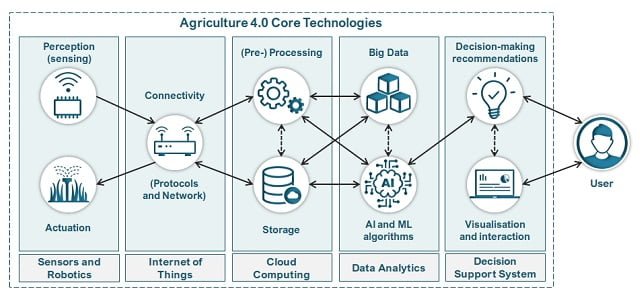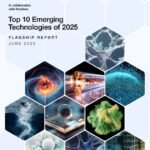
As the global population continues to grow, the demand for food is reaching unprecedented levels. Agriculture, the backbone of human civilization, faces the enormous challenge of feeding a growing population while preserving the delicate balance of our planet.
In response to this formidable task, Agriculture 4.0, also known as the Fourth Agricultural Revolution or smart agriculture, emerges as a beacon of hope, promising to transform the way we cultivate and revolutionize food production. Agriculture 4.0 utilizes digital technologies to advance toward a smarter, more efficient, and environmentally responsible agricultural sector (Javaid et al., 2022), based on the technologies shaping Industry 4.0.
From Agriculture 1.0 to 4.0
Agriculture has undergone a remarkable evolution over the centuries, each stage marked by advancements that have shaped our food systems. Let’s delve into the fascinating journey of agriculture through the ages:
Agriculture 1.0: The Traditional Approach
Agriculture 1.0, the first form of agriculture, relied on human labor and simple tools. Farmers tilled the land, sowed seeds, and harvested with their own hands and basic implements. This subsistence farming provided sustenance to local communities but struggled to meet the demands of a growing population.
Agriculture 2.0: The Mechanization Revolution
The Industrial Revolution ushered in Agriculture 2.0, characterized by the introduction of machinery and steam power. Tractors, harvesters, and threshers replaced manual labor, significantly increasing productivity and enabling farmers to cultivate larger areas of land. This era marked a turning point in agriculture and laid the foundation for future advancements.
Agriculture 3.0: The Biorevolution
The Green Revolution of the mid-20th century gave rise to Agriculture 3.0, an era marked by scientific advancements in genetics, fertilizers, and pesticides. High-yield crop varieties, along with increased use of chemical inputs, revolutionized agriculture and led to a surge in food production. However, this era also raised concerns about environmental sustainability and the long-term effects of intensive farming practices.
Agriculture 4.0: The Data-Driven Precision Era
Agriculture 4.0 represents the current transformation in agriculture, driven by the integration of cutting-edge technologies and data analytics. This era aims to address the limitations of previous agricultural models by optimizing resource utilization, minimizing environmental impact, and empowering farmers with data-driven decision-making.
What is Agriculture 4.0?
According to Gyamfi et al., (2024), Agriculture 4.0, or smart agriculture, involves the integration of sophisticated technologies such as IoT sensors, robotics, artificial intelligence, big data analytics, and cloud computing platforms to digitize and enhance agricultural processes.
Smart agriculture poses four essential requirements: increasing productivity, reasonably allocating resources, adapting to climate change, and preventing food waste (Zhai et al., 2020). Additionally, decision support systems in smart agriculture enable governments to optimize resource allocation, particularly for limited resources like water through irrigation mapping (Yousaf et al., 2023).
Technologies Shaping Agriculture 4.0
Agriculture 4.0 is equipped with a powerful arsenal of technologies transforming the agricultural landscape. Araújo et al., (2021) and Javaid et al., (2022) report that the fourth revolution in agriculture encompasses all processes of digitization and automation in business and daily life, including Big Data, Artificial Intelligence (AI), the Internet of Things (IoT), and virtual and augmented reality; in addition to robotics and automation.
Artificial Intelligence (AI): The Smart Brain of Agriculture 4.0
AI algorithms are revolutionizing agriculture by analyzing large amounts of data from sensors, weather stations, and satellite images. AI can predict crop yields, identify pests and diseases, optimize irrigation schedules, and even guide autonomous agricultural machinery.
Internet of Things (IoT): Connecting Fields and Farms to a Digital Network
Sensors embedded in fields, machinery, and livestock provide real-time data on soil moisture, nutrient levels, plant health, and animal welfare. This data is transmitted through IoT, allowing farmers to remotely monitor their operations and make timely adjustments.
Chataut et al., (2023) report that IoT applies in:
- Automation: IoT devices with sensors can automate tasks such as irrigation by monitoring soil moisture and activating sprinklers only when needed, saving water and improving efficiency.
- Data-Driven Decision Making: IoT sensors collect vast amounts of data on various farm conditions. Analyzing this data helps farmers make informed decisions about resource allocation, crop performance, and sustainable practices.

Robotics and Automation: Empowering Farmers with Smart Machines
Robots are taking over repetitive tasks such as harvesting, weeding, and sorting, reducing labor costs and improving efficiency. Automated systems can also control irrigation, fertilization, and pest management, minimizing human intervention and enhancing precision.
Drones and Unmanned Aerial Vehicles (UAVs): Eyes in the Sky for Precision Agriculture
Drones equipped with cameras and sensors can inspect fields, assess crop health, identify areas needing attention, and even apply pesticides and fertilizers with precision. Drones provide farmers with a panoramic view of their operations, enabling them to make informed decisions quickly.
Cloud Computing
Cloud computing provides a platform to store and process large amounts of agricultural data. This data can be used to develop new applications and services for the agricultural sector.
Big Data and Analytics: Turning Raw Data into Actionable Insights
The vast amount of data generated by Agriculture 4.0 technologies is analyzed using sophisticated algorithms and data visualization tools. This data-driven approach provides farmers with actionable insights into crop performance, soil conditions, and resource utilization, enabling them to optimize their operations and maximize productivity.

Reaping the Benefits of Agriculture 4.0
According to Zhai et al., (2020) and Araújo et al., (2021), Agriculture 4.0 enables farmers to collect, analyze, and process vast amounts of agricultural data (weather, soil conditions, marketing, etc.) to make informed decisions and achieve higher profits.
Agriculture 4.0 holds immense promise for addressing the challenges of modern agriculture and paving the way toward a more sustainable future:
- Improved Productivity: Precision agriculture techniques can increase crop yields by optimizing resource utilization, minimizing waste, and addressing pests and diseases early on.
- Reduced Environmental Impact: By minimizing the use of fertilizers, pesticides, and water, Agriculture 4.0 can contribute to a more sustainable future. Precision irrigation and nutrient management can reduce water consumption and soil erosion, while targeted pest control can minimize the use of harmful chemicals. Rose and Chilvers (2018) state that smart agriculture can provide enormous benefits to sustainable agriculture, increasing the efficiency and productivity of food creation, and potentially providing environmental and social benefits.
- Better Food Quality: Enhanced monitoring and control of growing conditions can lead to safer and higher-quality food products. Data-driven insights can help farmers optimize crop maturity, reduce post-harvest losses, and ensure compliance with food safety standards.
- Empowered Farmers: Access to real-time data and decision-support tools can empower farmers to make informed decisions, improve their livelihoods, and adapt to changing environmental conditions. Agriculture 4.0 can bridge the knowledge gap between farmers and experts, enabling them to adopt better practices and optimize their farming operations.
Examples of Agriculture 4.0
Computer Vision and Disease Control
Anand et al., (2023) propose that integrating computer vision and robotics offers a powerful approach to disease control; the researcher outlines the fundamentals of computer vision for disease detection (acquisition, processing, image analysis) and discusses the role of robotics in disease control (autonomous robots, selective pesticide application). Finally, they provide real-world examples and success stories of this technology in action.
Drones for Plant Phenotyping
Bongomin et al., (2024) report the use of drones specifically designed or adapted to capture high-resolution images of crops in the fields; specialized software analyzes the captured images and extracts valuable data on plant health, growth patterns, and other crucial characteristics, enabling quicker and more informed decisions in breeding programs.
Digital Twins
Cesco et al., (2023) propose a framework for designing agricultural information systems consisting of four key phases (i.e., data collection, data processing, data analysis and evaluation, and information utilization) based on the infologic approach. They applied the framework to present and discuss a field application of smart agriculture and digital twins in nitrogen (N) fertilization of crops.
Moreover, Priyadarshan et al., (2024) report that the following areas will benefit from smart agriculture, including some examples:
- Resource Efficiency: Minimizing the use of water, energy, and materials in agriculture. Javaid et al., (2022) summarize experiences in using sensors to monitor soil conditions, water levels, and nutrients.
- Controlled Environment Agriculture: Growing crops in controlled environments with high efficiency in the use of water, soil, and fertilizers.
- Precision Agriculture: Utilizing AI and data analytics for more precise decision-making and resource allocation. Medel-Jiménez et al., (2024) report that precision agriculture technologies have the potential to improve the environmental sustainability of agriculture: climate change, air and water pollution, and soil health.
- Protected Agriculture: Using greenhouses to create controlled environments for optimal crop growth.
- Remote Sensing: Employing sensor technology and data analysis for early detection of crop issues.
Addressing the Challenges of Smart Agriculture: Ensuring Equitable and Inclusive Adoption
Da Silveira et al., (2023) conducted a study with farmers in southern Brazil and concluded that the most frequent and significant barriers to the adoption of smart agriculture mentioned by farmers were: lack of infrastructure, lack of accessible solutions for farmers, need to promote R&D and innovative business models, risk by age groups, and lack of efficacy in data on the rural environment.
In this regard, despite its transformative potential, Agriculture 4.0 also presents challenges that must be addressed to ensure equitable and inclusive adoption:
- Bridging the Digital Divide: Ensuring equitable access to technology, training, and broadband connectivity is crucial to avoid marginalizing smallholder farmers and rural communities. Targeted interventions and support programs can close the digital divide and empower all farmers to participate in the digital transformation of agriculture.
- Protecting Data Privacy and Security: Robust cybersecurity measures are essential to protect sensitive agricultural data from unauthorized access and breaches. Implementing data privacy regulations and industry standards is necessary to ensure farmers’ data is secure and used responsibly.
- Addressing Ethical Implications: The use of gene editing and other advanced technologies raises ethical concerns that must be carefully considered. Open dialogue and collaboration between scientists, policymakers, and the public are essential to ensure that Agriculture 4.0 is developed and implemented responsibly and ethically.
Advantages and Disadvantages of Agriculture 4.0
Agriculture 4.0 offers a promising path toward a more sustainable, productive, and equitable food system. By addressing the challenges and seizing the opportunities of this technological revolution, we can cultivate a future where food security and environmental stewardship go hand in hand.
Table: Advantages and Disadvantages of Smart Agriculture
Aquí tienes una tabla que resume la información proporcionada:
| Advantages | Disadvantages |
|---|---|
| Increased Productivity | Digital Divide |
| – Precision agriculture techniques can increase crop yields by optimizing resource use, minimizing waste, and addressing pests and diseases early. | – Ensuring equitable access to technology, training, and broadband connectivity is crucial to avoid marginalizing small farmers and rural communities. |
| Reduced Environmental Impact | Data Privacy and Security |
| – By minimizing the use of fertilizers, pesticides, and water, Agriculture 4.0 can contribute to a more sustainable future. Precision irrigation and nutrient management can reduce water consumption and soil erosion, while targeted pest control can minimize the use of harmful chemicals. | – Robust cybersecurity measures are essential to protect sensitive agricultural data from unauthorized access and breaches. Data privacy regulations and industry standards must be implemented to ensure that farmers’ data is secure and used responsibly. |
| Better Food Quality | Ethical Implications |
| – Enhanced control and monitoring of growing conditions can lead to safer and higher-quality food products. Data-driven insights can help farmers optimize crop maturity, reduce post-harvest losses, and ensure compliance with food safety standards. | – The use of gene editing and other advanced technologies raises ethical concerns that must be carefully considered. Open dialogue and collaboration between scientists, policymakers, and the public are essential to ensure that Agriculture 4.0 is developed and implemented responsibly and ethically. |
| Empowered Farmers | Implementation Cost |
| – Access to real-time data and decision-support tools can empower farmers to make informed decisions, improve their livelihoods, and adapt to changing environmental conditions. Agriculture 4.0 can bridge the knowledge gap between farmers and experts, enabling them to adopt best practices and optimize their farming operations. | – The initial costs of implementing Agriculture 4.0 technologies can be a barrier for some farmers, particularly small farmers in developing countries. |
| Greater Efficiency | Dependence on Technology |
| – Automation and robotics can reduce labor costs, improve efficiency, and allow farmers to focus on higher-value tasks. | – Excessive reliance on technology could lead to the loss of traditional agricultural knowledge and skills. |
Charting the Course towards a Sustainable Future with Agriculture 4.0
To harness the full potential of Agriculture 4.0, a multifaceted approach involving collaboration among governments, research institutions, the private sector, and farmers is required, based on training, capacity building, financing, collaboration networks, and a farmer-centric approach (Gyamfi et al., 2024). In a study conducted with farmers in Bangladesh, Alam et al., (2023) report that “Automation and robotics to reduce labor usage,” “Augmented Reality (AR) to empower new farmers and guide tool assessment,” and “Providing adequate financial incentives to impoverished farmers to build modern storage facilities” are the three most influential drivers for implementing Agriculture 4.0.
In this regard, policymakers could pursue some of the following strategies:
- Promotion of Public-Private Partnerships: Collaboration among governments, research institutions, and the private sector is essential to effectively harness the potential of technological devices in the agricultural sector, drive innovation, develop affordable technologies, and facilitate their adoption by farmers. Public-private partnerships can pool resources, share experiences, and accelerate the development and implementation of Agriculture 4.0 solutions.
- Farmer Education: Education and training programs are essential to equip farmers with the skills and knowledge necessary to utilize Agriculture 4.0 technologies effectively. Silva et al., (2023) highlights that among the main barriers to the adoption of smart agriculture is the need for users to have more advanced knowledge and skills, underscoring the need to invest in operator training; in this regard, educational and training programs should be implemented to equip farmers with the necessary skills to use these technologies effectively (Karunathilake et al., 2023).
- Investment in Infrastructure: Investing in broadband connectivity, data centers, and digital skills training is crucial to support the digital transformation of agriculture. Infrastructure investments can ensure that farmers have access to the technology and training needed to utilize Agriculture 4.0 tools effectively.
- Establishment of Supportive Policy Frameworks: Supportive policies and regulations are needed to encourage investment, promote responsible innovation, and address ethical concerns. Policymakers can offer incentives for technology adoption, establish data privacy regulations, and promote research on the ethical implications of Agriculture 4.0 technologies.
Conclusion: Embracing Agriculture 4.0 for a Sustainable and Food-Secure Future
Agriculture 4.0 is at the forefront of a revolution that has the potential to transform how we feed the world. By embracing this technological revolution, we can enhance productivity, reduce environmental impact, improve food quality, and empower farmers to thrive in a changing world. However, to ensure that Agriculture 4.0 benefits everyone, we must address the challenges of the digital divide, data security, and ethical considerations.
Through collaboration, investment, and supportive policies, we can harness the power of Agriculture 4.0 to create a sustainable and food-secure future for all.
References
Alam, M. F. B., Tushar, S. R., Zaman, S. M., Gonzalez, E. D. S., Bari, A. M., & Karmaker, C. L. (2023). Analysis of the drivers of Agriculture 4.0 implementation in the emerging economies: Implications towards sustainability and food security. Green Technologies and Sustainability, 1(2), 100021. https://doi.org/10.1016/j.grets.2023.100021
Anand, R., Madhusudan, B. S., & Bhalekar, D. G. (2024). Computer Vision and Agricultural Robotics for Disease Control. In Applications of Computer Vision and Drone Technology in Agriculture 4.0 (pp. 31-47). Singapore: Springer Nature Singapore.
Araújo, S. O., Peres, R. S., Barata, J., Lidon, F., & Ramalho, J. C. (2021). Characterising the Agriculture 4.0 Landscape—Emerging Trends, Challenges and Opportunities. Agronomy, 11(4), 667. https://doi.org/10.3390/agronomy11040667
Bongomin, O., Lamo, J., Guina, J. M., Okello, C., Ocen, G. G., Obura, M., Alibu, S., Owino, C. A., Akwero, A., & Ojok, S. (2024). UAV image acquisition and processing for high-throughput phenotyping in agricultural research and breeding programs. The Plant Phenome Journal, 7(1), e20096. https://doi.org/10.1002/ppj2.20096
Cesco, S., Sambo, P., Borin, M., Basso, B., Orzes, G., & Mazzetto, F. (2023). Smart agriculture and digital twins: Applications and challenges in a vision of sustainability. European Journal of Agronomy, 146, 126809. https://doi.org/10.1016/j.eja.2023.126809
Chataut, R., Phoummalayvane, A., & Akl, R. (2023). Unleashing the Power of IoT: A Comprehensive Review of IoT Applications and Future Prospects in Healthcare, Agriculture, Smart Homes, Smart Cities, and Industry 4.0. Sensors, 23(16), 7194. https://doi.org/10.3390/s23167194
Da Silveira, F., Da Silva, S. L. C., Machado, F. M., Barbedo, J. G. A., & Amaral, F. G. (2023). Farmers’ perception of the barriers that hinder the implementation of agriculture 4.0. Agricultural Systems, 208, 103656. https://doi.org/10.1016/j.agsy.2023.103656
Gyamfi, E. K., ElSayed, Z., Kropczynski, J., Yakubu, M. A., & Elsayed, N. (2024). Agricultural 4.0 Leveraging on Technological Solutions: Study for Smart Farming Sector. arXiv preprint arXiv:2401.00814.
Javaid, M., Haleem, A., Singh, R. P., & Suman, R. (2022). Enhancing smart farming through the applications of Agriculture 4.0 technologies. International Journal of Intelligent Networks, 3, 150-164. https://doi.org/10.1016/j.ijin.2022.09.004
Karunathilake, E. M., Le, A. T., Heo, S., Chung, Y. S., & Mansoor, S. (2023). The Path to Smart Farming: Innovations and Opportunities in Precision Agriculture. Agriculture, 13(8), 1593. https://doi.org/10.3390/agriculture13081593
Medel-Jiménez, F., Krexner, T., Gronauer, A., & Kral, I. (2024). Life cycle assessment of four different precision agriculture technologies and comparison with a conventional scheme. Journal of Cleaner Production, 434, 140198. https://doi.org/10.1016/j.jclepro.2023.140198
Priyadarshan, P.M., Penna, S., Jain, S.M., Al-Khayri, J.M. (2024). Digital Agriculture for the Years to Come. In: Priyadarshan, P.M., Jain, S.M., Penna, S., Al-Khayri, J.M. (eds) Digital Agriculture. Springer, Cham. https://doi.org/10.1007/978-3-031-43548-5_1
Rose, D. C., & Chilvers, J. (2018). Agriculture 4.0: Broadening Responsible Innovation in an Era of Smart Farming. Frontiers in Sustainable Food Systems, 2, 387545. https://doi.org/10.3389/fsufs.2018.00087
Silva, F. T., Baierle, I. C., Correa, R. G., Sellitto, M. A., Peres, F. A., & Kipper, L. M. (2023). Open Innovation in Agribusiness: Barriers and Challenges in the Transition to Agriculture 4.0. Sustainability, 15(11), 8562. https://doi.org/10.3390/su15118562
Yousaf, A., Kayvanfar, V., Mazzoni, A., & Elomri, A. (2023). Artificial intelligence-based decision support systems in smart agriculture: Bibliometric analysis for operational insights and future directions. Frontiers in Sustainable Food Systems, 6, 1053921. https://doi.org/10.3389/fsufs.2022.1053921
Zhai, Z., Martínez, J. F., Beltran, V., & Martínez, N. L. (2020). Decision support systems for agriculture 4.0: Survey and challenges. Computers and Electronics in Agriculture, 170, 105256. https://doi.org/10.1016/j.compag.2020.105256
Editor and founder of “Innovar o Morir” (‘Innovate or Die’). Milthon holds a Master’s degree in Science and Innovation Management from the Polytechnic University of Valencia, with postgraduate diplomas in Business Innovation (UPV) and Market-Oriented Innovation Management (UPCH-Universitat Leipzig). He has practical experience in innovation management, having led the Fisheries Innovation Unit of the National Program for Innovation in Fisheries and Aquaculture (PNIPA) and worked as a consultant on open innovation diagnostics and technology watch. He firmly believes in the power of innovation and creativity as drivers of change and development.





